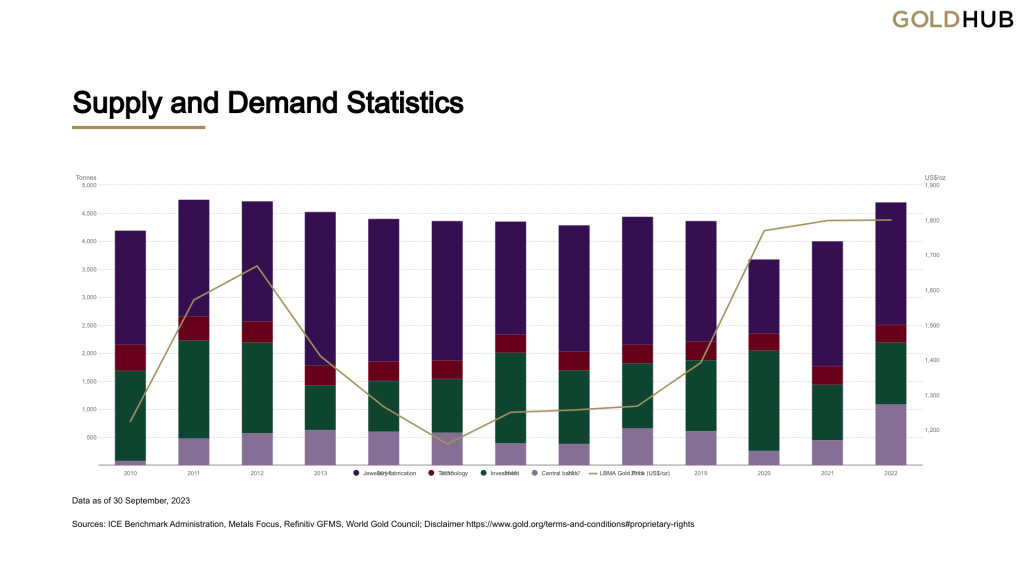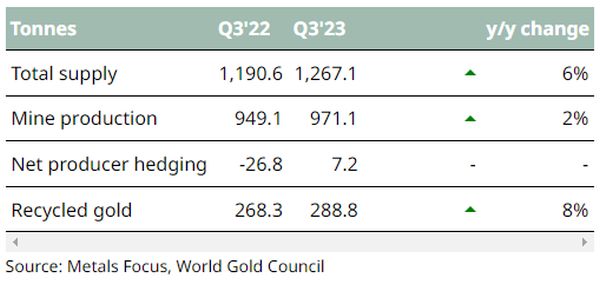Recycling gold is becoming increasingly popular nowadays as a way to reduce the environmental impact of mining and to create a more sustainable supply of gold. Sustainability and going green is taking a center stage across multiple industries, same is with obtaining/extracting gold and this industry is also undergoing a profound transformation. The spotlight now shines on the growing trend of jewelry recycling as well as electronics recycling, a movement that is reshaping the dynamics of the global gold market.
Traditionally, the gold market has been synonymous with mining and extraction, leading to environmental concerns and ethical debates. However, a paradigm shift is underway as more consumers and industry players recognize the potential of recycling as a sustainable alternative. The act of repurposing gold from existing jewelry as well as electronic goods, not only mitigates the environmental impact of mining but also aligns with the growing demand for ethical and responsible practices.
In 2023 the Recycled gold market rose to 289 Tons, that’s 8% increase on a yearly basis. At the same time, the mining production also saw a huge rise and it reached 971.1 Tons (2% Increase on a yearly basis). What this shows is that the gold recycling market is growing and at a much faster rate compared to the mining output. It is visible in the data as well. The total global precious metal recycling market was valued at 15.56 Billion USD in 2022 and it is said to grow up to 22.1 Billion USD by the end of 2029.

Digging further we can find some reasons what the gold recycling market has to offer.
It has several benefits, and it also has its environmental and economic impact overall:
Environmental Conservation
Reduced Mining Impact: This is one of the topmost talking points across the world. Gold mining does have a significant environmental footprint, which includes deforestation, habitat disruption, and water pollution. Recycling gold does decreases the need for new mining activities, lowering the overall environmental impact. According to a study published in The International Journal of Life Cycle Assessment, high-value gold scrap recycling has a considerably lower environmental impact than electronic gold scrap recycling and mining. For example, high-value gold scrap recycling in Germany results in a cumulative energy demand (CED) of 820 MJ and a global warming potential (GWP) of 53 kg-CO2-Eq. per kg gold.
According to a report by the World Gold Council, India has recycled 75 tonnes of gold in 2021, ranking fourth globally while China topped the list by recycling 168 tonnes of gold, and its followed by Italy and the United States.
Resource Conservation
Preservation of Finite Resources: Gold is a finite resource which is the foundation of its intrinsic value, therefore recycling does helps extend its usability by reusing existing materials and reducing the pressure on its limited natural reserves.
Energy Savings
Less Energy Intensive: Extracting gold from ore is energy-intensive. Recycling gold requires less energy compared to the mining and refining processes, this in turn contributes to energy conservation and a much smaller carbon footprint compared to normal mining activity.
Economic Advantages
Market Stability: Incorporating recycled gold into the market provides a stable supply source. It helps meet demand without relying solely on fluctuations in newly mined gold production, contributing to market stability. According to the World Gold Council, the global gold demand was 8% above its five-year running average in the third quarter of 2023. It has came down significantly after that and it was down by 6% year-on-year to 1,147 tons in July-September. But this shows that sudden spikes in demand would be absorbed by the gold recycling market.
Financial Opportunities
Value Extraction: Recycling allows for the extraction of valuable gold from electronic waste, old jewelry, and other sources, turning what might be considered waste into a valuable resource. As of now, it is used as an industrial metal with a broad range of applications, but most of its demand is driven by the electronics sector which accounts for a whopping 80% of the gold that is used in the technology sector.
Reduced Waste
Mitigation of E-Waste: As electronics use almost 80% of Gold used in technology today it is commonly found in used and sometimes outdated electronic devices. Recycling these devices prevents the disposal of electronic waste, reduces the environmental impact associated with improper disposal and gives it a 2nd life to be used in new electronic devices.
Consumer Preferences
Meeting Sustainability Demands: The top five countries by the end of 2023, that consumed gold are: China, India, United States, UAE and Indonesia. In some places, with a growing consumer awareness and preferences for sustainable products, jewelry made from recycled gold aligns with the ethical and eco-friendly choices of the customers. As modern consumers are becoming more educated towards greener alternatives, they seek not just exquisite craftsmanship but also ethical and eco-friendly choices. It’s a win-win situation for everyone.
Technological Innovation
Promotion of Advanced Techniques: Gold recycling promotes the development and use of advanced technologies for refining and processing, improving efficiency and reducing environmental impacts associated with traditional extraction methods.
Corporate Responsibility
Enhanced Corporate Image: Companies that incorporate recycled gold in their products demonstrate environmental responsibility, enhancing their corporate image and attracting consumers who prioritize sustainability. This shift not only adds a green touch to their brands but also taps into a market segment that is increasingly prioritizing sustainability.
Circular Economy Contribution
Promoting Circular Practices: Gold recycling is a key component of a circular economy, where materials are reused and repurposed, contributing to a more sustainable and resource-efficient economic model. For example, recycled gold supply reach more than 288.8 tons by the end of last year as per the World Gold Council. That is 20.3 Billion USD worth of Gold recycled by the 3rd Quarter of 2023. It helps countries like China, India and Indonesia by lowering their imports and saving their forex reserves which would have seen an outflow in normal circumstances.

Challenges and Opportunities
Navigating the Road Ahead: While the momentum of gold recycling is undeniable, challenges are there. Issues related to collection infrastructure, consumer awareness, and standardization of recycled gold are some of them. However, these challenges do present opportunities, for collaboration, innovation, and market differentiation.
Conclusion
A thorough look at the current trends in the gold recycling market shows an overall positive outlook. Recycled gold is becoming a major player, affecting both the environment and the economy as a whole. As people, businesses, and technology all move in this direction, the future of the global gold market looks promising and carries a sense of responsibility.

